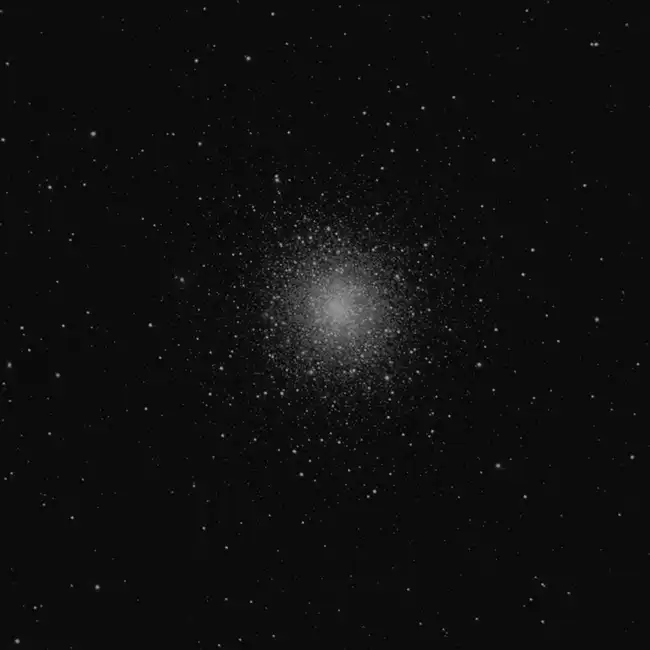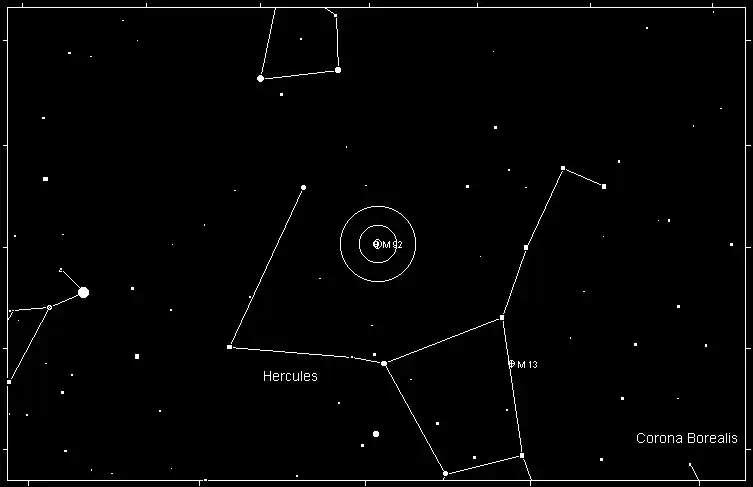Messier 92 (M92) is a magnificent globular cluster located in the constellation Hercules. This cluster is a dense collection of stars, packed tightly together in a roughly spherical shape, and is one of the oldest and most luminous clusters in the Milky Way galaxy. M92 is an impressive sight in the night sky, shining with a combined brightness that makes it easily visible even with modest amateur telescopes.
The cluster is composed of hundreds of thousands of stars, many of which are red giants and old, metal-poor stars. It spans about 109 light-years in diameter and is located approximately 26,700 light-years from Earth. The stars within M92 are around 13.8 billion years old, making this cluster nearly as old as the universe itself.
Magnitude
Messier 92 has an apparent magnitude of 6.4, which means it is just on the edge of visibility to the naked eye under extremely dark skies. For most observers, however, a pair of binoculars or a small telescope is necessary to see it clearly. Through a telescope, M92 reveals a bright, densely packed core surrounded by a halo of stars, which become more discernible with higher magnifications.

Best Season for Observation
M92 is best observed during the spring and summer months in the Northern Hemisphere, from April to September. It reaches its highest point in the sky in June, making this the ideal time for viewing. During this period, the constellation Hercules, where M92 is located, is well-positioned in the night sky, offering optimal viewing conditions.
Constellation: Hercules
M92 resides within the boundaries of the constellation Hercules, a prominent constellation in the Northern Hemisphere. Hercules is known for its shape, which resembles a keystone or an hourglass. The constellation is rich in deep-sky objects, with M92 being one of its most notable treasures, alongside its more famous neighbor, Messier 13 (the Hercules Cluster).
How to Find Messier 92 with a Telescope
Finding M92 in the night sky is relatively straightforward, especially if you are already familiar with the constellation Hercules. To locate it, start by identifying the "Keystone," the asterism that forms the central part of Hercules. The Keystone is a quadrilateral of stars that stands out prominently in the constellation.
- Identify the Keystone: Look for the four stars that form this quadrilateral—Epsilon, Zeta, Eta, and Pi Herculis.
- Locate the Position of M92: M92 is located north of the Keystone, about one-third of the way between the star Pi Herculis (at the northern end of the Keystone) and the star Iota Herculis (outside the Keystone, to the northeast).
- Use a Telescope: Point your telescope at the approximate location. At low magnification, M92 will appear as a faint, fuzzy spot. Increase the magnification to resolve individual stars within the cluster and to appreciate its densely packed core.

History of Messier 92
Messier 92 was discovered by the German astronomer Johann Elert Bode on December 27, 1777. Charles Messier, the French astronomer who compiled the famous Messier catalog, independently discovered the cluster on March 18, 1781, and subsequently included it as the 92nd entry in his catalog of "nebulous objects." Although Messier's catalog primarily focused on objects that could be confused with comets, it has since become a vital list for deep-sky observers.
Over the centuries, M92 has been studied extensively, revealing much about the nature of globular clusters and the evolution of stars. Its great age and relatively low metal content provide astronomers with insights into the early history of the Milky Way galaxy. Modern observations with large telescopes and space-based instruments have allowed astronomers to study the individual stars within M92 in great detail, further enhancing our understanding of this ancient stellar system.
Conclusion
Messier 92 is a spectacular globular cluster that offers a glimpse into the early universe. Its brightness and compactness make it a rewarding target for amateur astronomers, especially during the spring and summer months when Hercules dominates the night sky. Whether viewed through binoculars, a small telescope, or a more advanced instrument, M92 remains a stellar gem that continues to captivate and inspire stargazers around the world.
